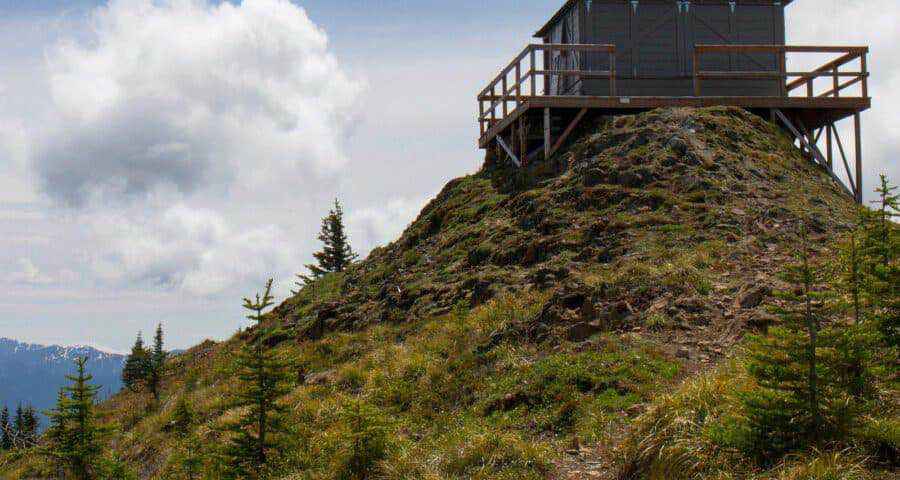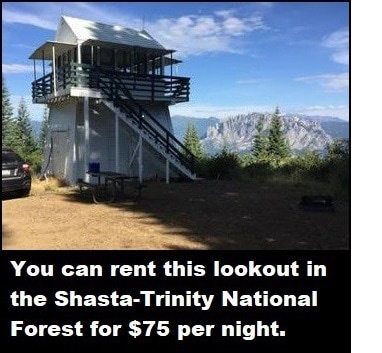
Wildfire Lookouts: Still Useful After All These Years
Down valley a smoke haze
Three days heat, after five days rain
Pitch glows on the fir-cones
Across rocks and meadows
Swarms of new flies.
A few friends, but they are in cities.
Drinking cold snow-water from a tin cup
Looking down for miles
Through high still air.
“Mid-August at Sourdough Mountain Lookout”
Acclaimed American poet Gary Snyder penned those words to describe the blissful solitude he experienced while manning a wildfire lookout high in the Cascades during the summer of 1953. His Beat Generation cohort, Jack Kerouac, also served as a fire lookout three summers later.
Both writers drew inspiration from the seclusion of their mountain-top lookout posts. You probably didn’t know that.
Here are four other things you probably didn’t know about wildfire lookouts:
Early on, Women “Manned” Them Too
The country’s first fire lookout tower was erected on Maine’s Squaw Mountain in 1905. Six years later, in 1913, Hallie Daggett became the Forest Service’s first female fire lookout. She spent 15 years in that position, at the Eddy Gulch fire tower in California’s Klamath National Forest.
Upon hiring Daggett, Assistant Fire Ranger M.H. McCarthy cautioned his boss, “I hope your heart is strong enough to stand the shock.” In an effort to cushion the blow, McCarthy added that Daggett “is absolutely devoid of the timidity which is ordinarily associated with her sex.”
He also assured his supervisor that they would not be overrun by female applicants in the future “since we can hardly expect these positions to ever become very popular with the Fair Sex.” Daggett, however, not only eagerly longed for the station, but enjoyed the life and was intensely interested in the work.
A 1914 issue of American Forestry stated:
Some of the [Forest] Service men predicted that after a few days of life on the peak she would telephone that she was frightened by the loneliness and the danger, but she was full of pluck and high spirit … and she grew more and more in love with the work… She not only filled the place with all the skill which a trained man could have shown, but she desires to be reappointed when the fire season opens this year [1914].
In describing her life as a lookout, Hallie said she had a “firm determination to make good, for I knew that the appointment of a woman was rather in the nature of an experiment, and naturally felt that there was a great deal due the men who had been willing to give me the chance.”
For the next 30 years, only a handful of women served as lookouts. Then came WWII, and women began staffing the lookouts in droves. The tradition has continued ever since.
Lookouts Pulled Double-Duty During WWII, the Cold War
During WWII, the U.S. Army Air Force utilized fire lookouts across the country as enemy aircraft observation points. In order to staff the towers, the Air Force recruited civilian observers through its newly created Ground Observer Corps. Two or more watchers staffed each lookout 24 hours a day, 365 days a year, until the war ended.
The GOC was resurrected during the Cold War in 1950. By 1952, the total number of GOC volunteers exceeded 800,000, working at 16,000 observation posts throughout the country. Of course, not all of these posts were fire lookout towers, but the fire lookouts were particularly useful in sparsely populated areas.
According to David W. Mills, author of Cold War in a Cold Land, ranger stations and fire lookout towers maintained by the National Forest Service provided the GOC with “a number of posts with little organizational effort or cost.” And most rangers and fire watchers enjoyed the extra duty as a break from the monotony.
As one U.S. forestry official put it, “We are glad to be of service tour air defense system. Skywatching fits perfectly into our fire lookout program, since both are designed to provide protection against destructive enemies.”
Alas, by the late fifties, radar technology had superseded the need for the GOC; it was disbanded on January 31, 1959.
But now…
They’re Making a Comeback
Most fire lookout towers have long been replaced by cameras, satellite technology and better communications systems. But there are a few areas of the country where they’re making a comeback.
In San Diego County, for instance, two of the area’s three towers have recently been brought back to life by dedicated volunteers, working with the federal and state government.
And in Pennsylvania, new fire towers are going up for the first time in decades. In fact, state officials are investing in 16 of the towers as a cost-effective means of surveillance. Keith Argow, chairman of the Forest Fire Lookout Association (FFLA), thinks Pennsylvania is making a smart move. Outside of fire towers, he said, there aren’t many effective ways to spot smoke within a short period of time.
US Forest Service spokeswoman Kassidy Kern agrees. “The biggest piece of this puzzle is to keep fires small. And the way to do that is to have someone who is vigilant and scanning,” she said.
Which is why thousands of volunteers and paid personnel still staff fire lookout towers at national parks and forests across the country. People like Leif Haugen, who has spent the last 24 summers as a fire lookout in Montana.
Here’s a look at his typical day:
At the peak of their popularity in the 1940s, the U.S. had about 8,000 lookouts, many constructed by the Civilian Conservation Corps. Today, only about 800 staffed lookouts remain, mostly in the West, replaced primarily by aircraft.

But aircraft can only remain aloft for limited periods. Which means they can miss the faint or intermittent smoke from a budding wildfire. A fire lookout can zero in on the area and spend more time observing it. The result is a better understanding of the overall situation.
Organizations like FFLA and the Buck Rock Foundation are dedicated to preserving the tradition of fire lookouts. These and other lookout enthusiasts work with the Forest Service in historical restoration projects. As a result, some fire lookouts are now also functioning as museums, interpretive centers, wildlife observation posts and vacation rentals.
Which brings us to our last point…
The Forest Service Rents Them Out
If you’re up for an adventure, you can rent an unmanned lookout tower for up to 180 days. Rates vary from about $40 to $75 per night, and accommodations are spartan, but you can’t beat the view!
Bear in mind that this is not your typical camping trip. You’ll want to read the rental descriptions carefully before reserving your lookout.
Click here for a list of fire lookouts currently available for rent in each state.

The National Forest Foundation offers the following suggestions before embarking on your lookout adventure:
- Bring Water – This may seem obvious, but there are very limited water options on the mountaintop. If you need to refill, you’ll have to drive or hike to a lower elevation. So bring more than you think you’ll need.
 Bring Warm Clothes – While there’s no need to pull out your winter parka, temperatures in the higher elevations will be cold, even during the hottest summer days.
Bring Warm Clothes – While there’s no need to pull out your winter parka, temperatures in the higher elevations will be cold, even during the hottest summer days.- Call Ahead – Check with the local ranger district office for updates on wildlife in the area, road conditions and more. They’re the best resource, since they manage and check in on the towers regularly.
- Don’t Get Locked Out – Many of the lookout towers will be locked. So before your visit, it’s important that you contact the ranger office to obtain access to the combination code.
- Bring a Sleeping Bag – Although the description of the rental will include a bed, don’t expect it to be like home. (It may be a simple mat on top of elevated plywood.) So bring a sleeping bag, a pad and a pillow.
- Pack It In/Pack It Out – As with all backcountry hideaways, whatever you bring in you are expected to take with you.
Sources:
Featured Image: U.S. Forest Service, Public Domain




